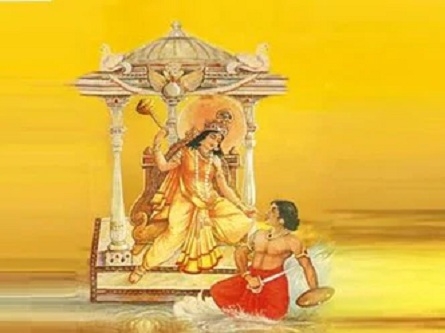Bagalamukhi - The Goddess of Speech
02 Apr 2020 10:03:49

By Rajendra Diwe :
Bagalamukhi Devi is the eighth of the ten Mahavidyas. Bagalamukhi Mantra is very popular amongst the devotees. The devotees believe, “This mantra evokes innumerable advantages for all round protection, prosperity stability and offers protection against diseases, chronic problems and accidents. Regular Japa of the ‘Bagalamukhi Mantra’ is said to paralyses the ego and actions of a person who tries to harm us.” ‘Dasha Mahavidya’ published by Geeta Press Gorakhpur describes, “Bagalamukhi means ‘The Crane-Headed One’. This bird is thought of as the essence of deceit. As can be seen from the hymn, she rules magic for the suppression of an enemy’s gossip.
These enemies also have an inner meaning, and the peg she puts through the tongue may be construed as a peg or paralysis of our own prattling talk. She rules deceit which is at the heart of most speech. She can in this sense be considered as a terrible or Bhairavi form of Matrika Devi, the mother of all speech.” Bagala is another of the frightening forms of the Goddess. Her color is yellow. She is clad in yellow clothing and is adorned with yellow ornaments and yellow flowers (particularly the champak flower). With her left hand she catches her opponent’s tongue and with her right she strikes him on head with her mace. She sits upon a golden throne surrounded by red lotuses. By some accounts she wears the crescent moon as a jewel on her head. Seekers of Tantra Sadhana say, “Recitation of Bagalamukhi Mantra is believed to have miraculous powers.
‘Bagalamukhi Mantra’ is known to ensure victory over enemies. ‘Bagalamukhi Mantra’ is specially suggested for people in administration and management cadres, politicians, those facing debts or litigation problems, etc. ‘Bagalamukhi Mantra’ can be used by a person who is facing losses in business, financial problems, false court cases, false accusations, debt problems, obstacles in profession, etc. ‘Bagalamukhi Mantra’ is effective for those appearing for competitive exams, debates, etc. It also helps in warding off evil spirits and evil eye.”
David Kinsley in his famous books ‘Hindu Goddesses: Visions of the Divine Feminine in the Hindu Religious Tradition. Berkeley: University of California Press’; ‘Tantric Visions of the Divine Feminine: The Ten Mahavidyas. Delhi: University of California Press’ and Shankaranarayanan S in his book ‘The Ten Great Cosmic Powers (Dasa Mahavidyas). Pondicherry: Dipti Publications’ have elaborated in length about spiritual importance of Baglamukhi Devi. Kinsley writes, “Bagalamukhi or ‘Bagala’ (she who has a crane’s head) is one of the ten mahavidyas, but myths of her origins also come with various interpretations. These origins seem to illustrate several distinct variations of Bagalamukhi’s character.
For example, the first myth associates ‘Bagala’ with the God Visnu, where she plays a role similar to one of his avatars, in which, Visnu comes across a cosmic crisis that threatens to annihilate the universe and after requesting for aid, ‘Bagala’ emerges and restores the cosmic balance.” “The next origin myth describes Bagalamukhi’s well-known ability of ‘Stambhana’ (to stun or paralyse). ‘Bagala’ is often associated with paralysing enemies, and defeating enemies with Vak siddhi (the power of speech). In this myth ‘Bagala’ stops the demon ‘Madan’, a demon that is able to destroy and kill just by speaking. ‘Bagala’ is often portrayed by grabbing the demon’s tongue, stopping him from uttering any more words before destroying him,” Kinsley mentions. Shankaranarayanan describes, “The third and final myth recounts the origin of both Dhumavati and Bagalamukhi.
This origin myth is similar to the encounter that the ten Mahavidyas have with Siva, in which Bagalamukhi is a manifestation of Siva’s wife. However, in this version, Bagala is manifested after Parvati devours Siva. Soon after Parvati consumes Siva, smoke begins to be released from Parvati’s body. Consequently, Siva emerges from Parvati’s body, followed by Siva punishing her by stripping her of the marks and adornments of marriage, leaving her a widow. Parvati is then branded Bagalamukhi for eating Siva, and from her smoke or her maya (the power of illusion) emerges Dhumavati. This myth relates closely to the meaning of Bagalamukhi’s name, in which, similarly to how a crane would eat, ‘Bagala’ swallows Siva whole.” David Frawley terms, “Bagala is a Goddess of speech, and as such is related to Tara and regarded as a form of her.
When sound becomes manifest as light, Tara becomes Bagala. When the brilliant light of speech comes forth, then Tara gains the effulgence of Bagala and causes all things to become still. Bagala is thus the stunning radiance that comes forth from the Divine Word and puts the human or egoistic word to rest. Bagala gives a power of speech that leaves others silent and grasping for words. She gives the decisive statement, the irrefutable conclusions, the pronouncement of ultimate truth. Hence she is propitiated for success in discussions and debates. No one can defeat her because she has the truth power of the self-nature.”